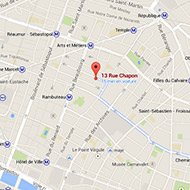For several years, Lenny Rébéré has been developing a personal technique based on collecting images from the internet, film clips and personal pictures. He reproduces these images by keeping only their outlines and superimposes them, always making sure he ?piles up? the lines and values using pencil and charcoal. This means taking his drawings to the threshold of obscurity before allowing streaks of light to filter through by playing with the balance of whites and blacks. These piles of representations, sometimes decentred, sometimes cropped (close-ups, details), create chance encounters between the characters who inhabit them and reveal the depths of field of the final image.
By distancing himself from reality ? in his paper, canvas or glass pieces (engraved and oil-painted glass) alike ? Lenny Rébéré invents situations to come. Here, an empty set whose bareness is unsettling; there, the possibility of a meeting which may not happen. In his stage designs, the artist alternates between the representation of crowds, the agglutination of bodies to the point that the canvas is suffocated by flesh, and the giddiness of absence. Each of his drawings gives off a feeling of incompleteness typically aroused by the disappearance of beings and things, and questions the constant shakiness of our lives.
These feelings of confusion and strangeness are invitations to see between and beyond the images by taking our time, time to decipher them as we would a rebus: enter the drawing to see and put one?s imagination to work, pick out the puzzles and details; investigate, let one?s eye acclimatize. In these works, the visual streams of advertising, selfies, smooth, flat1 photographs that make our lives blind become material serving a body of work which encourages us to make up stories.
A poet of the image, Lenny Rébéré engraves a world made of apparitions, imbued with neo-romanticism and darkness. His lines urge us to adjust our eye to the ?zero of seeing and feeling?2 so that it can seize what these paintings are offering clear-sightedly. In this way, the artist invites us to experiment our ability to invent what we see, for the duration of an act of contemplation.
JULIE ROSSELLO-ROCHET,
Playwright, June 2016.
1 Cf. Eric de Chassey, Platitudes : une histoire de la photographie plate [?Platitudes: a history of flat photography?], Paris: Gallimard, 2006, (Art and artists)
2 Hans Bellmer, Little Anatomy of the Physical Unconscious: Or, The Anatomy of the Image [1957], Waterbury: Dominion, 2004.


